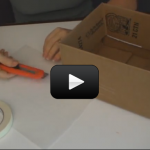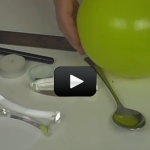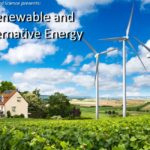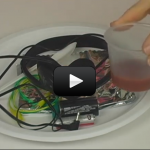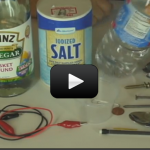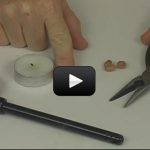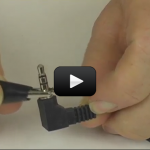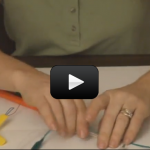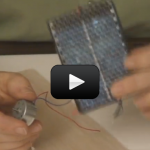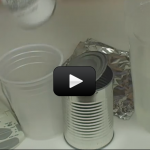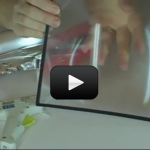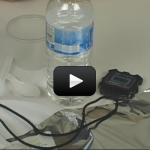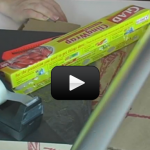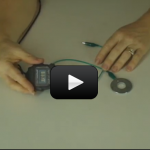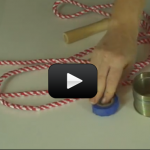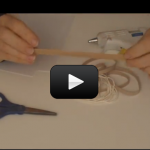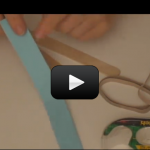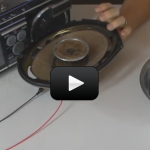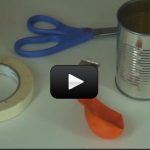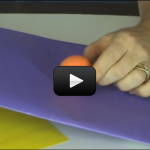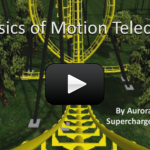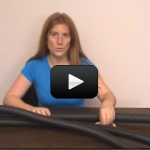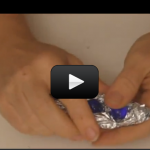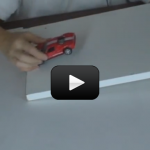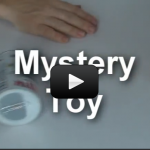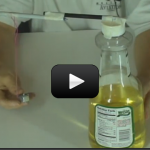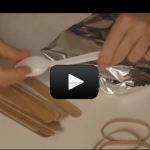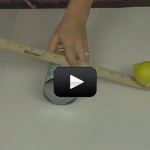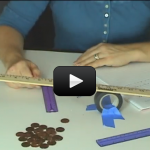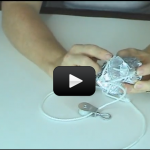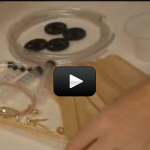Pinhole Camera
This is the simplest form of camera – no film, no batteries, and no moving parts that can break. The biggest problem with this camera is that the inlet hole is so tiny that it lets in such a small amount of light and makes a faint image. If you make the hole larger, you … Continue reading "Pinhole Camera" |
Eyeballoon
In this lab, we are going to make an eyeball model using a balloon. This experiment should give you a better idea of how your eyes work. The way your brain actually sees things is still a mystery, but using the balloon we can get a good working model of how light gets to your … Continue reading "Eyeballoon" |
Special Science Teleclass: Renewable & Alternative Energy
This is a recording of a recent live teleclass I did with thousands of kids from all over the world. I’ve included it here so you can participate and learn! Discover the world of clean, renewable energy that scientists are developing today! Explore how they are harnessing the energy of tides and waves, lean how … Continue reading "Special Science Teleclass: Renewable & Alternative Energy" |
Can a Battery Be Used to Store Energy?
A battery is a device that produces electrical energy from a chemical reaction. Another name for a battery is voltaic cell. Voltaic means to make electricity.Most batteries contain two or more different chemical substances. The different chemical substances are usually separated from each other by a barrier. One side of the barrier is the positive … Continue reading "Can a Battery Be Used to Store Energy?" |
Salty Battery
Using ocean water (or make your own with salt and water), you can generate enough power to light up your LEDs, sound your buzzers, and turn a motor shaft. We’ll be testing out a number of different materials such as copper, aluminum, brass, iron, silver, zinc, and graphite to find out which works best for … Continue reading "Salty Battery" |
Do Plants Store Energy?
A peanut is not a nut, but actually a seed. In addition to containing protein, a peanut is rich in fats and carbohydrates. Fats and carbohydrates are the major sources of energy for plants and animals. The energy contained in the peanut actually came from the sun. Green plants absorb solar energy and use it … Continue reading "Do Plants Store Energy?" |
Can Electricity Be Made From Sunlight?
The solar cell you are using for this experiment is made from the element silicon. Silicon solar cells consist of two thin wafers of treated silicon that are sandwiched together. The treated silicon is made by first melting extremely pure silicon in a special furnace. Tiny amounts of other elements are added which produce either … Continue reading "Can Electricity Be Made From Sunlight?" |
Solar Boat
Does it really matter what angle the solar cell makes with the incoming sunlight? If so, does it matter much? When the sun moves across the sky, solar cells on a house receive different amounts of sunlight. You’re going to find out exactly how much this varies by building your own solar boat. We’re going … Continue reading "Solar Boat" |
Solar Car
Solar energy (power) refers to collecting this energy and storing it for another use, like driving a car. The sun blasts 174 x 1015 watts (which is 174,000,000,000,000,000 watts) of energy through radiation to the earth, but only 70% of that amount actually makes it to the surface. And since the surface of the earth … Continue reading "Solar Car" |
Can the Sun Be Used to Heat Water?
The energy of sunlight powers our biosphere (air, water, land, and life on the earth’s surface). About 50 percent of the solar energy striking the earth is converted to heat that warms our planet and drives the winds. About 30 percent of the solar energy is reflected directly back into space. The water cycle (evaporation … Continue reading "Can the Sun Be Used to Heat Water?" |
Marshmallow Roaster
Do you like marshmallows cooked over a campfire? What if you don’t have a campfire, though? We’ll solve that problem by building our own food roaster – you can roast hot dogs, marshmallows, anything you want. And it’s battery-free, as this device is powered by the sun. NOTE: This roaster is powerful enough to start … Continue reading "Marshmallow Roaster" |
How Can the Sun Be Used for Cooking?
Cooking involves heating food to bring about chemical changes. Sometimes foods are heated simply because the food tastes better warm than cold. In making tea, we sometimes heat water to help dissolve tea or help dissolve sugar if the tea is sweetened. Normally the water used to make tea is heated on a range top … Continue reading "How Can the Sun Be Used for Cooking?" |
Solar Cookies
Can you use the power of the sun without using solar cells? You bet! We’re going to focus the incoming light down into a heat-absorbing box that will actually cook your food for you. Remember from Unit 9 how we learned about photons (packets of light)? Sunlight at the Earth’s surface is mostly in the … Continue reading "Solar Cookies" |
What is Frequency?
In this experiment you will be adjusting the length of string of a pendulum until you get a pendulum that has a frequency of .5 Hz, 1 Hz and 2 Hz. Remember, a Hz is one vibration (or in this case swing) per second. So .5 Hz would be half a swing per second (swing … Continue reading "What is Frequency?" |
Transverse and Longitudinal Waves
Since we can’t see soundwaves as they move through the air, we’re going to simulate one with rope and a friend. This will let you see how a vibration can create a wave. You’ll need at least 10 feet of rope (if you have 25 or 50 feet it’s more fun), a piece of tape … Continue reading "Transverse and Longitudinal Waves" |
Buzzing Hornets
Sound is everywhere. It can travel through solids, liquids, and gases, but it does so at different speeds. It can rustle through trees at 770 MPH (miles per hour), echo through the ocean at 3,270 MPH, and resonate through solid rock at 8,600 MPH. Sound is made by things vibrating back and forth, whether it’s … Continue reading "Buzzing Hornets" |
Harmonicas
Your voice is a vibration, and you can feel it when you place a hand on your throat when you speak. As long as there are molecules around, sound will be traveling though them by smacking into each other. That’s why if you put an alarm clock inside a glass jar and remove the air, … Continue reading "Harmonicas" |
Seeing Sound Waves
This section is actually a collection of the experiments that build on each other. We’ll be playing with sound waves, and the older students will continue on after this experiment to build speakers. |
Seeing Sound Waves using Light
After you've completed this experiment, you can try making your own sound-to-light transformer as shown below. |
Inclined Plane
What’s an inclined plane? Jar lids, spiral staircases, light bulbs, and key rings. These are all examples of inclined planes that wind around themselves. Some inclined planes are used to lower and raise things (like a jack or ramp), but they can also used to hold objects together (like jar lids or light bulb threads). Here’s … Continue reading "Inclined Plane" |
Special Science Teleclass: Physics of Motion
This is a recording of a recent live teleclass I did with thousands of kids from all over the world. I’ve included it here so you can participate and learn, too! We’re going to cover energy and motion by building roller coasters and catapults! Kids build a working catapult while they learn about the physics … Continue reading "Special Science Teleclass: Physics of Motion" |
Roller Coasters
We're going to build monster roller coasters in your house using just a couple of simple materials. You might have heard how energy cannot be created or destroyed |
Bobsleds
Bobsleds use the low-friction surface of ice to coast downhill at ridiculous speeds. You start at the top of a high hill (with loads of potential energy) then slide down a icy hill til you transform all that potential energy into kinetic energy. |
Go Go GO!!
This is a nit-picky experiment that focuses on the energy transfer of rolling cars. You'll be placing objects and moving them about to gather information about the potential and kinetic energy. |
Mystery Toy
first, and when you're done with the heavy nut from that activity, just use it in this experiment. You can easily create one of these mystery toys out of an old baking powder can, a heavy rock, two paper clips, and a rubber band (at least 3" x 1/4"). It will keep small kids and cats busy for hours. |
Pendulums
This is a very simple yet powerful demonstration that shows how potential energy and kinetic energy transfer from one to the other and back again, over and over. Once you wrap your head around this concept, you'll be well on your way to designing world-class roller coasters. |
Catapults
When you drop a ball, it falls 16 feet the first second you release it. If you throw the ball horizontally, it will also fall 16 feet in the first second, even though it is moving horizontally… it moves both away from you and down toward the ground. |
Human Levers
Levers are classified into three types: first class, second class, or third class. Their class is identified by the location of the load, the force moving the load, and the fulcrum. In this activity, you will learn about the types of levers and then use your body to make each type. |
The SeeSaw
We're going to use everyday objects to build a simple machine and learn how to take data. Sadly, most college students have trouble with these simple steps, so we're getting you a head start here. The most complex science experiments all have these same steps that we're about to do... |
Simple Pulley Experiments
Are you curious about pulleys? This set of experiments will give you a good taste of what pulleys are, how to thread them up, and how you can use them to lift heavy things. |
Hydraulic Pneumatic Earth Mover
When people mention the word “hydraulics”, they could be talking about pumps, turbines, hydropower, erosion, or river channel flow. The term “hydraulics” means using fluid power, and deals with machines and devices that use liquids to move, lift, drive, and shove things around. |

